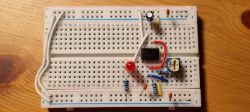FAQ
TL;DR: A 30 W, 1.037 MHz musical Tesla coil proves that “Tesla coil is essentially a radio transmitter” [Elektroda, bambus94, post #20144574] while remaining buildable with two BD239 transistors [Elektroda, patrykkurzejago, post #20144206] Safe handling and proper tuning are critical. Why it matters: Even small coils can burn skin, jam Wi-Fi and broadcast unintended RF.
Quick Facts
• Resonant frequency: 1.037 MHz detected with RTL-SDR [Elektroda, patrykkurzejago, post #20144646]
• Supply: 30 V DC from trimmed 36 V SMPS [Elektroda, patrykkurzejago, post #20144206]
• Output power: ≈30 W at 1 A [Elektroda, patrykkurzejago, post #20144206]
• Windings: Primary 5 turns / 1.5 mm; Secondary ≈1000 turns / 0.25 mm [Elektroda, patrykkurzejago, post #20144206]
• SDR coverage 0.1 MHz–1.7 GHz with R820T2 tuner [Elektroda, patrykkurzejago, post #20144595]
1. What schematic was the starting point for this build?
The author began with a single-transistor SSTC diagram found online, then redrew it to use two BD239 NPN transistors, an LED across the bases and an ESP8266 audio gate [Elektroda, patrykkurzejago, post #20144206]
2. Which modifications increased spark length?
Increasing primary turns from 3 → 5, raising supply to 30 V and adding ~1000 secondary turns boosted spark visibility and lamp excitation [Elektroda, patrykkurzejago, post #20144206]
3. Why were BD239 transistors chosen?
BD239s handle 1 A continuous and 65 V Vceo; their higher dissipation cut burnout frequency compared with earlier TO-92 devices [Elektroda, patrykkurzejago, post #20144206]
4. How does the coil play music?
An ESP8266 outputs a square-wave melody; a 2N7000 FET grounds the transistor bases rhythmically, amplitude-modulating the RF and producing audible plasma tones [Elektroda, patrykkurzejago, post #20144206]
5. How can I measure resonance without an oscilloscope?
Use an RTL-SDR dongle: the coil radiates; tune from 0.5–5 MHz until you see a strong peak (1.037 MHz in this project) [Elektroda, patrykkurzejago, post #20144646] Alternatively, compute f ≈ 1 / (2π√LC) with online calculators when L and C are known.
6. Is it safe to touch the discharge?
No. A brief contact burned a 2 mm-wide, 5 mm-deep hole in the builder’s hand despite “not feeling current” [Elektroda, patrykkurzejago, post #20816932] Skin effect reduces deep conduction but does not prevent RF burns [Elektroda, lazor, post #20152362]
7. What effects on nearby electronics were observed?
Google Nest speakers in the next room randomly changed volume; fluorescent lamps lit from ≥30 cm; smart-band and phone survived close passes [Elektroda, patrykkurzejago, post #20146027]
8. Can I raise the supply voltage for bigger arcs?
Yes, but transistor heating rises with frequency. Users report safe operation up to 30 V; beyond that, core losses and transistor SOA limit apply [Elektroda, patrykkurzejago, post #20144206]
9. How do I tune a Tesla coil efficiently?
- Wind secondary first and calculate its self-resonance. 2. Start with extra primary turns. 3. Slide an alligator clip to vary inductance until spark length maximises and transistor heat minimises [Elektroda, rosomak19, post #20147034]
10. What is the wavelength-equals-wire-length debate?
Some hobbyists aim for secondary wire length ≈ ½ λ; others focus solely on LC resonance. Experts note performance depends on L and C, not wire length alone [Elektroda, Janusz_kk, post #20145799]
11. Which gases form around the arc?
Ozone and nitrogen oxides form; litmus paper turned red near the arc, confirming NOx presence [Elektroda, patrykkurzejago, post #20147860] Prolonged exposure above 0.1 ppm ozone irritates lungs [EPA, 2023].
12. What primary and secondary wires work best?
Use 1–2 mm² copper for the primary to handle currents; 0.2–0.3 mm enamelled magnet wire suits a 25 cm secondary, giving ≈1000 turns [Elektroda, patrykkurzejago, post #20144206]
13. How can I reduce transistor heating?
Lower resonance by adding a toroid or increasing secondary height; reduced frequency cuts switching losses. Ensure a heat-sink keeps case <70 °C [Elektroda, Janusz_kk, post #20145799]
14. What myths surround the skin effect?
High-frequency current still penetrates tissues because the body is ionic and inhomogeneous; skin effect does not guarantee safety, especially in DRSSTC class where peak discharge current can reach amps [Elektroda, KJ, post #20162812]
15. 3-step: Measure frequency with RTL-SDR
- Power the coil a short distance from the antenna.
- Open SDR software, set range 0.5–5 MHz, gain low.
- Identify the strongest peak (e.g., 1.037 MHz) and note harmonics. [Elektroda, patrykkurzejago, post #20144646]





